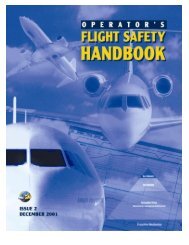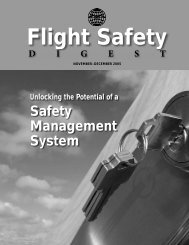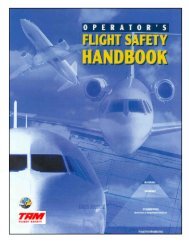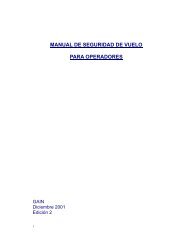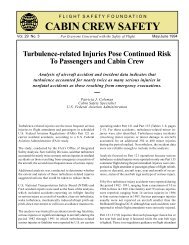Download PDF [10.9 MB] - Flight Safety Foundation
Download PDF [10.9 MB] - Flight Safety Foundation
Download PDF [10.9 MB] - Flight Safety Foundation
Create successful ePaper yourself
Turn your PDF publications into a flip-book with our unique Google optimized e-Paper software.
Base: © User:Tubs/Wikimedia Commons CC-SA-BY 3.0<br />
FLIGHTOPS<br />
a reality and that related information<br />
and data will evolve rapidly.<br />
An earlier ICAO document predicted<br />
that the integration process would<br />
be “a long-term activity with many<br />
stakeholders adding their expertise on<br />
such diverse topics as licensing and<br />
medical qualification of … crew, technologies<br />
for detect-and-avoid systems,<br />
frequency spectrum (including its protection<br />
from unintentional or unlawful<br />
interference), separation standards<br />
from other aircraft and development of<br />
a robust regulatory framework.” 1<br />
50 Site Applications<br />
In the United States, current activity<br />
centers on the FAA’s preparations to<br />
select six UAS test ranges — required<br />
by a 2012 law — that will be used to<br />
“develop a body of data and operational<br />
experiences to inform integration and<br />
the safe operation of these [UAS] aircraft<br />
in the National Airspace System.” At the<br />
same time, the FAA has set a late April<br />
deadline for receiving public comment<br />
on its proposed methods of addressing<br />
privacy concerns associated with UAS<br />
operations within the test site program.<br />
The FAA says it received 50 applications<br />
for test sites in 37 states (map).<br />
Rules governing the site selection<br />
process preclude the FAA from disclosing<br />
details of the applications, but the<br />
agency has said that its goal is to select<br />
six sites that will enable the study of<br />
UAS operations under all types of<br />
conditions — in a wide variety of geographical<br />
locations and climate conditions,<br />
for example — and in areas with<br />
varying air traffic density and ground<br />
infrastructure. Varying research needs<br />
also will be considered.<br />
Site selections are expected to be<br />
announced late this year.<br />
Meanwhile, state officials and others<br />
representing UAS concerns have outlined<br />
their proposals.<br />
For example, Oklahoma, which<br />
vowed to “compete aggressively” to host<br />
one of the FAA UAS test sites, said in<br />
a 2012 report by the Oklahoma UAS<br />
Systems Council that it already had at<br />
least 15 private companies “involved in all<br />
facets of UAS,” along with related research<br />
and development programs, education<br />
and training, and a detailed plan to develop<br />
the UAS industry in the state. 2<br />
Among the UAS projects under<br />
consideration in Oklahoma are those<br />
involving oil and gas pipeline inspection,<br />
weather monitoring and several areas<br />
of radar development, including radar<br />
aeroecology, which uses radar to detect<br />
States with applicants<br />
the behavior of birds and other airborne<br />
animals — a technology that might<br />
eventually help prevent bird strikes.<br />
Ohio, which joined with Indiana in<br />
applying for an FAA test site designation,<br />
in 2012 established the Ohio UAS Center<br />
and Test Complex, described by James<br />
Leftwich, the state’s special adviser for<br />
UAS initiatives, as “a problem-solver and<br />
door-opener for anyone who needs airspace,<br />
access to ground facilities, research<br />
and analytic support and everything else<br />
it takes to move the UAS frontier forward<br />
safely, successfully and steadily.” 3<br />
UAS Markets<br />
A study released in March by the Association<br />
for Unmanned Vehicle Systems<br />
International (AUVSI) estimated that,<br />
in the first three years after the planned<br />
2015 integration of UAS into U.S.<br />
airspace, the industry will create 70,000<br />
new jobs. By 2025, the number will top<br />
100,000, according to projections. 4<br />
The study projected the largest market<br />
for UAS in the United States would<br />
be the precision agriculture industry,<br />
which would use UAS to monitor crops<br />
and apply pesticides. Another major<br />
market would be in public safety.<br />
Some public safety uses, including<br />
surveillance, have prompted objections<br />
from critics who cite privacy concerns,<br />
including the American Civil Liberties<br />
Union (ACLU), which warns that<br />
“routine aerial surveillance would profoundly<br />
change the character of public<br />
life in America.<br />
“Rules must be put in place to ensure<br />
that we can enjoy the benefits of this new<br />
technology without bringing us closer to<br />
a ‘surveillance society’ in which our every<br />
move is monitored, tracked, recorded and<br />
scrutinized by the government.” 5<br />
Some state legislatures are considering<br />
action to regulate the use of UAS in<br />
surveillance, and at least one — Virginia,<br />
24 | FLIGHT SAFETY FOUNDATION | AEROSAFETYWORLD | MAY 2013


![Download PDF [10.9 MB] - Flight Safety Foundation](https://img.yumpu.com/18550968/26/500x640/download-pdf-109-mb-flight-safety-foundation.jpg)

![Download this Issue [PDF 7 MB] - Flight Safety Foundation](https://img.yumpu.com/18859635/1/190x245/download-this-issue-pdf-7-mb-flight-safety-foundation.jpg?quality=85)
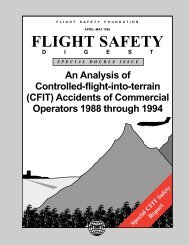
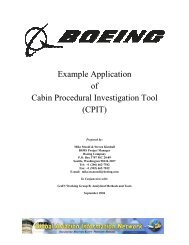
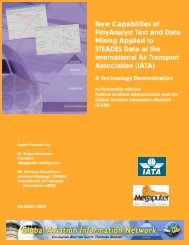
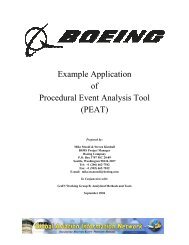

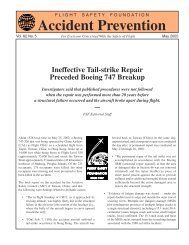
![Download [PDF 8 MB] - Flight Safety Foundation](https://img.yumpu.com/18859366/1/190x245/download-pdf-8-mb-flight-safety-foundation.jpg?quality=85)
